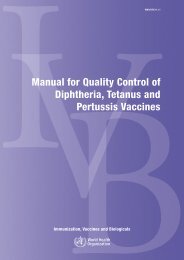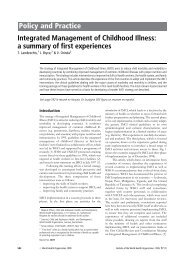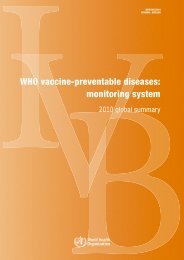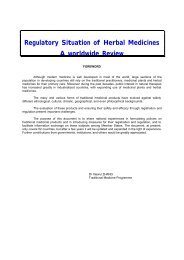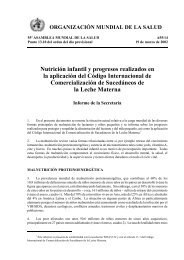IPDE - Extranet Systems - World Health Organization
IPDE - Extranet Systems - World Health Organization
IPDE - Extranet Systems - World Health Organization
You also want an ePaper? Increase the reach of your titles
YUMPU automatically turns print PDFs into web optimized ePapers that Google loves.
A. W. Loranger<br />
had more than one personality disorder, including 55 (15.0%) with two,<br />
32 (8.7%) with three, and 24 (6.6%) with more than three disorders. Of<br />
the 283 patients with an ICD-l0 personality disorder diagnosis, 96<br />
(33.9%) had more than one type of disorder, including 57 (20.1%) with<br />
two, 27 (9.5%) with three, and 12 (4.2%) with more than three disorders.<br />
What are the implications of a patient having more than one form of<br />
mental disorder, particularly more than one type of PD? In some<br />
instances this may merely reflect the fact that twoor more disorders share<br />
similar symptoms or diagnostic criteria. For example, subsme abuse<br />
may be indicative of p r impulse control. a characteristic of antisocial,<br />
emotionally unstable or borderline PD. Similarly, social withdrawal is a<br />
diagnostic criterion shared by both schizoid and avoidant PDs. Another<br />
implication may be pmgnostic or therapeutic, with one disorder modifying<br />
the course or outcome of another. There is evidence, for example, that<br />
depression is less responsive to treatment, when accompanied by a PD.<br />
Comorbidity may also be a consequence of the fact that two disorders<br />
share similar etiologies. Finally, at times comorbidity may also he an<br />
indication of a defective or less thanoptimal classification system.<br />
A fundamental problem in interpreting the meaning of the comorbidity<br />
findings from various sNdies, including this one, is that they are<br />
markedly influenced by the base rates of the disorders in the sample.<br />
These in turn are a function of the admission practices of the facilities<br />
from which the patients are drawn, not to mention the selection biases<br />
for inclusion in the studies themselves. Ideally, comorbidity should he<br />
determined from epidemiological studies based on probability samples<br />
from the community. Unfortunately these rarely if ever include a suffi-<br />
cient number of cases of most disorders, to provide definitive information<br />
about the hue CO-occurrence rates of the disorders in question.<br />
ICD-10 and DSM-IICR<br />
As previously noted, ICD-10 and DSM-111-R are different but overlapping<br />
classification systems. There are slight differences in nomenclature:<br />
anankastidobsessive-compulsive, anxious/avoidant, and dissociaUantisocial.<br />
In ICD-10 borderline and impulsive are viewed as subtypes of<br />
emotionally unstable; schiwtypal is located with schizophrenia and<br />
delusional disorders; and narcissistic, passive-aggressive, and the two<br />
disorders in the appendix of DSM-111-R, sadistic and self-defeating, do<br />
not appear. There are also several significant differences in the criteria in<br />
the two systems and some minor variations in their wording. Except for




